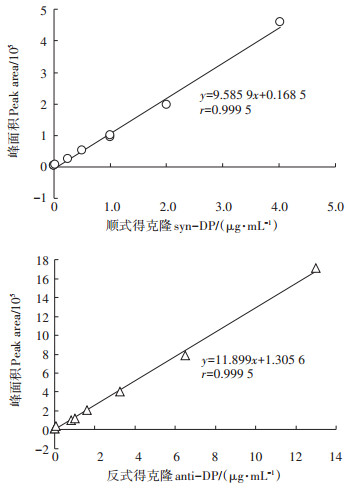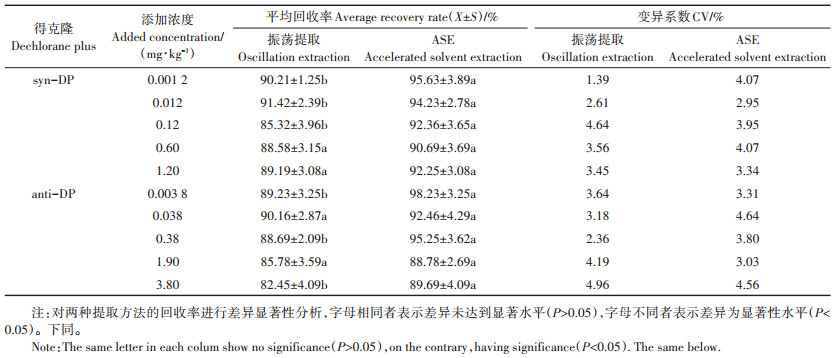2. 土肥资源高效利用国家工程实验室, 山东农业大学资源与环境学院, 山东 泰安 271018
2. National Engineering Laboratory for Efficient Utilization of Soil and Fertilizer Resources, College of Resources and Environment, Shandong Agricultural University, Tai'an 271018, China
高氯代阻燃剂得克隆(Dechlorane plus,简称DP,C18H12C112),即双(六氯环戊二稀)环辛烷,是一种高产量化学品添加剂,用于计算机显示器、电视、家具和电线涂层中的电硬塑料连接器中,其存在两种异构体,分别为顺式得克隆(syn-DP)和反式得克隆(anti-DP)(比例约为1:3)[1]。DP具有远距离传输性[2]、生物富集性[3-5]和难降解性等持久性有机污染物(POPs)特性[6],因此环境中较低浓度的DP残留也会对生物有较大的影响[7-8]。DP使用量巨大,使用范围较广,在全球各环境介质中普遍存在[9-12],因此建立土壤和水稻中痕量DP的残留检测方法具有重要意义。
建立高特异性、高灵敏度的分析方法成为DP研究领域的关键,检测DP在各种环境介质中的含量水平,也是各项相关研究工作得以开展的基础。已有的研究采用气相色谱-负化学电离质谱法(GC-NCIMS)检测环境中DP类污染物[13-15],NCI选择性较低,易受基质干扰[16];Xu等[16]采用加速溶剂萃取(ASE)仪对土壤样品中的DP进行提取,硅胶层析柱净化浓缩,GC-NCI-MS进行测定;Zhu等[17]采用液相色谱-大气压化学电离-串联质谱法(LC-APCI-MS/MS)测定水中的DP;何畅等[18]采用正己烷-二氯甲烷混合液利用索氏提取器提取,旋转蒸发器浓缩,GC-MS(气质联用)法测定空气中的DP;刘合欢等[19]建立了利用气相色谱-串联质谱仪检测DP及其相关化合物在土壤样品中含量的方法。综合以上研究发现,虽然有不少关于DP残留的测定方法,但是由于谷物中的DP残留量很低,利用两种不同的提取方法,并结合EI离子源和GC-MS/MS的二级质谱检测方法检测谷物样品中DP残留的测定方法的报道还较少。
本研究采用振荡提取和加速溶剂萃取(ASE)两种预处理方法,利用EI离子源和GC-MS/MS的二级质谱检测方法,建立了土壤和大米中痕量DP的GCMS/MS的残留测定方法,能有效减少基质干扰,提高DP分析的选择性和灵敏度。
1 材料与方法 1.1 药品与试剂DP标准品(纯度100%,Accu Standard Inc公司)、syn-DP标样和anti-DP标样(Accu Standard Inc公司,甲苯配制)、正己烷(色谱纯,天津市凯通化学试剂有限公司)、二氯甲烷(色谱纯,天津市凯通化学试剂有限公司)、无水硫酸钠(分析纯,天津市凯通化学试剂有限公司)、硅胶(180~280目,克拉玛尔公司)。
1.2 仪器与设备TSQ 8000三重四极杆GC-MS/MS(Thermo Fisher Scientific)、ASE 150(Dionex)、RE-52AA旋转蒸发器(上海亚荣生化仪器厂)、SHZ-ⅢB循环水式多用真空泵(浙江临海市精工真空设备厂)、万分之一电子分析天平(梅特里,Mettler-Toledo Group)和移液管、SampliQ SPE-C18固相萃取小柱、玻璃棒、容量瓶、250 mL碘量瓶、布氏漏斗、平底烧瓶等玻璃器皿。
1.3 供试材料供试土壤采于山东农业大学南校区试验农场,采样深度为2~20 cm,取适量土壤于干净托盘上自然风干后,过40目筛装袋备用。大米购自农贸市场,粉碎后待用。
1.4 DP标准溶液的配制用万分之一天平称0.002 0 g DP(syn-DP和antiDP)标准样品于50 mL容量瓶,用正己烷溶解定容,配得400 mg·L-1的DP母液,再分别配制各种浓度的标准溶液:16、8、4、1.6、0.8、0.4、0.16、0.04 mg·L-1和0.008 mg·L-1,通过外标法进行定量分析。syn-DP和antiDP的单标溶液均为甲苯配制的50 mg·L-1的液体标样,采用正己烷稀释到0.05 μg·mL-1,进行定性分析。
1.5 土壤和大米中DP的提取净化方法振荡提取法:称取风干过筛的土壤(粉碎的大米样品)样品25.00 g到250 mL碘量瓶中,添加DP标准溶液至试验设定的浓度,在室温下平衡12 h后,加入70 mL的正己烷/二氯甲烷(1:1,V/V),在振荡器上振荡提取1 h后,用布氏漏斗减压抽滤,用30 mL正己烷分3次冲洗碘量瓶和滤渣,每次使用10 mL,合并滤液并经无水硫酸钠干燥后滤入250 mL的平底烧瓶,所有萃取液用旋转蒸发器于60 ℃下浓缩至1~3 mL,过硅胶柱层析净化。层析柱从下往上依次加入无水硫酸钠20.00 g、氧化铝(7.5%失活)5.00 g、硅胶(3%失活)3.00 g和无水硫酸钠20.00 g。用20.00 mL正己烷预淋洗,将上述浓溶液转移至层析柱中,用100 mL正己烷/二氯甲烷(1:1,V/V)混合液洗脱,收集全部淋洗液,用旋转蒸发器浓缩至1~2 mL,然后转移至10 mL容量瓶中,正己烷定容,用0.22 μm有机相滤膜过滤,待上机检测。添加浓度分别为0.005、0.05、0.5、2.5、5.0 mg·kg-1 5个水平于空白的土壤样品中,添加浓度分别为0.001、0.01、0.05、0.25、0.5 mg·kg-1 5个水平于空白的大米样品中,同时设置空白对照(不添加DP),每个处理设置5个平行样。
ASE:准确称取土壤(大米)样品10.00 g,加入3 g硅藻土作为分散剂,混合均匀,装入ASE 150样品池中,样品池的顶部和底部各垫一层玻璃纤维滤膜(美国Dionex公司),防止土壤和硅藻土阻塞管路。添加DP标准溶液至一定浓度,平衡过夜后,加10 mL正己烷/二氯甲烷(1:1,V/V),在100 ℃、10.34 MPa下萃取10 min,萃取液直接过SampliQ SPE-C18固相萃取小柱净化,净化后溶液定容到10 mL进行测定。样品中DP的添加浓度同振荡提取法。
1.6 仪器分析条件TSQ 8000三重四极杆GC-MS/MS:色谱柱采用DB-5MS柱(30 m×0.25 mm id,膜厚0.25 μm);初始温度为140 ℃,保持1 min,15 ℃·min-1升至285 ℃,保持1 min,60 ℃·min-1升至325 ℃,保持7 min;进样口温度为280 ℃,传输线和离子源的温度分别为280 ℃和290 ℃。氦气流速为1.0 mL·min-1,采用不分流模式进样1 μL,EI电离源,离子模式(SIM)进行定量分析。在该条件下,syn-DP和anti-DP的保留时间分别为15.41 min和15.92 min。
1.7 数据处理和分析样品的回收率采用SPSS 22.0进行显著性分析,采用单因素方差分析(ANOVA),通过P < 0.05的最小显著性差异(LSD)评价不同处理间回收率的差异显著性。方法的最小检出浓度采用公式计算:

|
DP的标准曲线见图 1。由图 1可知,syn-DP和anti - DP的线性方程为y=9.585 9x + 0.165 8和y= 11.899x+1.305 6,相关系数r均为0.999 5,线性范围分别在5.00×10-13~4.02×10-9 g和1.62×10-12~1.30×10-8 g之间,线性关系良好,线性范围较宽。在1.6检测条件下分别进样浓度均为0.1 μg·L-1的syn-DP 1 μL和anti-DP标准溶液0.50 μL,在信噪比为3的条件下,测得syn-DP和anti-DP最小检出量分别为1.00×10-13 g和5.0×10-14 g;土壤中syn-DP和anti-DP方法的最小检出浓度均为4.0×10-5 mg∙kg-1,大米中syn-DP和anti-DP方法的最小检出浓度均为1.0×10-4 mg∙kg-1。

|
图 1 顺式得克隆和反式得克隆的标准曲线 Figure 1 The standard curve of syn-DP and anti-DP |
采用GC-MS/MS检测分析,DP的标样和在土壤与大米样品中测定的总离子流图如图 2所示。

|
图 2 得克隆的总离子流图 Figure 2 Total ion chromatograms of DP |
如图 2所示,在试验设定的测定条件下,DP的两个异构体syn-DP和anti-DP的保留时间分别为15.41 min和15.92 min,anti-DP与syn-DP峰分离效果很好,而且峰形很好,均为尖头峰,没有拖尾和其他不良现象。在采用TSQ8000三重四极杆GC-MS/MS气质联用仪检测下,土壤和大米中较低添加浓度的DP的总离子流图的杂质峰很少,没有明显干扰物质存在,说明本试验采用的检测条件适合分析土壤和大米中DP的残留。
2.3 方法的准确度和精密度 2.3.1 DP在土壤中的添加回收率以DP在土壤中的添加回收率来衡量本试验方法的准确度,以变异系数(CV)表示方法的精密度,测得不同浓度下DP的添加回收率见表 1。
|
|
表 1 syn-DP和anti-DP在土壤中的添加回收率 Table 1 The recovery rate of syn-DP and anti-DP in the soil |
由表 1可知,采用振荡提取和ASE两种不同的样品前处理方法处理土壤样品时,DP的两种异构体syn-DP和anti-DP在土壤中的添加回收率均能达到残留分析方法的要求,ASE方法回收率略高于振荡提取方法,并且ASE方法简单、快速。对于syn-DP,在试验设定的添加浓度下,振荡提取和ASE方法添加回收率分别为85.32%~91.42%和90.69%~95.63%,变异系数均小于4.64%;对于anti-DP,在试验设定的添加浓度下,振荡提取和ASE方法添加回收率分别为82.45%~90.16%和88.78%~98.23%,变异系数均小于4.96%。
2.3.2 DP在大米中的添加回收率测得不同浓度下大米中DP的添加回收率结果见表 2。由表 2可知,采用振荡提取和ASE两种不同的样品前处理方法处理大米样品,syn-DP和anti-DP在大米中的添加回收率均能达到残留测定方法的要求,加速溶剂萃取仪因其加压使溶剂在高温下保持液态,并使萃取剂快速填满萃取池的特点,具有提取效率高、速度快和有机溶剂使用量少的优点,回收率分别为90.56%~98.56%和90.36%~96.56%,变异系数均小于5.05%,满足了痕量syn-DP和anti-DP残留分析方法的要求。振荡提取法因操作繁琐导致DP在样品预处理中损失较多,回收率小于ASE法,回收率分别为86.47%~90.24%和85.84%~89.61%,变异系数均小于4.53%。采用SPSS 22.0对两种提取方法的回收率进行差异显著性分析,结果表明添加较低浓度的处理具有显著差异,而添加较高浓度的处理无显著差异。
|
|
表 2 syn-DP和anti-DP在大米中的添加回收率 Table 2 The recovery rate of syn-DP and anti-DP in the rice |
利用本文建立的样品预处理方法和测定方法检测了盆栽试验中的土壤和大米中的残留量,土壤中syn-DP和anti-DP残留浓度分别为0.58 mg∙kg-1和1.76 mg∙kg-1,种植的水稻收获后测定大米中syn-DP和anti-DP残留量分别为0.28 ng∙g-1和0.79 ng∙g-1。
3 讨论在样品前处理中,DP与其他亲脂性有机化合物如多溴二苯醚和多氯联苯(PCBs)的方法相似,一般包括样品采集/预处理、样品提取、净化和仪器分析4步。气体中的DP采用聚氨酯泡沫(PUF)[20]和XAD-2树脂收集,空气中的颗粒物采用石英fiber filter收集;水样采用XAD[21]、PAD(苯乙烯和二乙烯基苯的共聚物)树脂或琥珀玻璃作为收集介质,鱼等生物样品需要先进行均质化,才能获得具有代表性的样品[22];底泥中的DP采用Tenax提取方法[23];土壤和植物样品利用二氯甲烷采用索氏提取法进行提取[24],萃取溶剂为丙酮、二氯甲烷[25]、正己烷、甲苯和二乙醚等[19],根据样品类型的不同,可采用液-液萃取[25]、固-液萃取[11]、索氏萃取[2]和ASE等多种萃取技术。萃取溶剂需要净化,一般采用简单的硅胶或氧化铝柱、复杂的多层和多吸附剂柱,对于生物样品,去除萃取物中的脂类和其他物质,凝胶渗透色谱法(GPC)[4]是最常用的方法,硫化法[21]也能破坏油脂含量。本研究利用混合有机溶剂正己烷/二氯甲烷(1:1,V/V)提取,采用振荡提取和ASE两种方法分别提取,采用SPE小柱净化,满足了样品中DP残留分析方法的要求。本研究采用的振荡提取法是传统的样品前处理方法,虽操作费时但一般实验室都能具备该提取条件,ASE为样品前处理的先进设备,价格昂贵但提取效率高,满足了现代化实验室的需要。
Hoh等[21]和Zhu等[12]在syn-DP和anti-DP商业化之前采用商品化的DP作为校准标准,而本研究利用甲苯配制的单标syn-DP和anti-DP分别进行定性分析,能更准确地检测分析。DP可采用GC-ECNCI-MS进行检测分析[20, 26-27],用甲烷气体电离,为了提高方法的灵敏度,可采用选择性离子监测(SIM)模式进行数据采集(质荷比m/z为651.8和653.8)[28];气相色谱配电子捕获检测器(GC-ECD)也能检测DP,Kang等[29]利用了电子碰撞模式下的高分辨率质谱(GC-HRMS)进行检测,Zhou等[30]采用液相色谱-大气压光电离串联质谱法分析了鱼体中36种卤代阻燃剂(包括DP)。本研究利用EI离子源和GC-MS/MS的二级质谱检测方法检测分析了土壤和大米样品中DP的两种异构体,灵敏度很高,非常适合痕量DP的检测分析。
4 结论(1)采用振荡提取和加速溶剂萃取两种方法对土壤和大米中得克隆残留进行提取,利用TSQ 8000三重四极杆GC-MS/MS的二级质谱检测分析,建立了土壤和大米中得克隆的残留测定方法。
(2)得克隆的两种同分异构体syn-DP和anti-DP在本测定条件下保留时间分别为15.41 min和15.92 min,线性范围比较宽(102),LOD分别为1.00×10-13 g和5.0×10-14 g,土壤中syn-DP和anti-DP方法的最小检出浓度均为0.40×10-4 mg∙kg-1,大米中syn-DP和anti-DP方法的最小检出浓度均为1.0×10-4 mg∙kg-1。
(3)syn-DP和anti-DP在土壤和大米中的添加回收率,快速溶剂萃取法均大于振荡提取法,在两种处理方法下,二者的回收率均能满足土壤和大米样品中得克隆痕量残留检测分析方法的要求。
| [1] |
Xian Q M, Siddique S, Li T, et al. Sources and environmental behavior of dechlorane plus:A review[J]. Environment International, 2011, 37(7): 1273-1284. DOI:10.1016/j.envint.2011.04.016 |
| [2] |
Möller A, Xie Z, Sturm R, et al. Large-scale distribution of dechlorane plus in air and seawater from the Arctic to Antarctica[J]. Environmental Science & Technology, 2010, 44(23): 8977-8982. |
| [3] |
Jia H L, Sun Y Q, Liu X J, et al. Concentration and bioaccumulation of dechlorane compounds in coastal environment of northern China[J]. Environmental Science & Technology, 2011, 45(7): 2613-2618. |
| [4] |
Wu J P, Zhang Y, Luo X J, et al. Isomer-specific bioaccumulation and trophic transfer of dechlorane plus in the fresh water foodweb from a highly contaminated site, south China[J]. Environmental Science & Technology, 2010, 44(2): 606-611. |
| [5] |
Li Y, Yu L H, Wang J S, et al. Accumulation pattern of dechlorane plus and associated biological effects on rats after 90 d of exposure[J]. Chemosphere, 2013, 90(7): 2149-2156. DOI:10.1016/j.chemosphere.2012.10.106 |
| [6] |
Sverko E, Tomy G T, Reiner E J, et al. Dechlorane and related compounds in the environment:A review[J]. Environmental Science & Technology, 2011, 45(12): 5088-5098. |
| [7] |
Wu J P, Chen X Y, Wu S K, et al. Dechlorane plus flame retardant in a contaminated frog species:Biomagnification and isomer-specific transfer from females to their eggs[J]. Chemosphere, 2018, 211: 218-225. DOI:10.1016/j.chemosphere.2018.07.146 |
| [8] |
江秀兰, 谢慧, 常晓云. 卤代阻燃剂和镉对旱稻种子萌发和生长的影响[J]. 农业环境科学学报, 2020, 39(7): 1460-1469. JIANG Xiu-lan, XIE Hui, CHANG Xiao-yun. Effects of halogenated flame retardants and cadmium on the germination and seedling growth of rice[J]. Journal of Agro-Environment Science, 2020, 39(7): 1460-1469. |
| [9] |
Syed J H, Malik R N, Li J. Levels, profile and distribution of dechloran plus(DP)and polybrominated diphenyl ethers(PBDEs)in the environment of Pakistan[J]. Chemosphere, 2013, 93(8): 1646-1653. DOI:10.1016/j.chemosphere.2013.08.054 |
| [10] |
Yu Z Q, Lu S Y, Gao S T. Levels and isomer profiles of dechlorane plus in the surface soils from e-waste recycling areas and industrial areas in south China[J]. Environmental Pollution, 2010, 158(9): 2920-2925. DOI:10.1016/j.envpol.2010.06.003 |
| [11] |
Zheng J, Wang J, Luo X J, et al. Dechlorane plus in human hair from an e-waste recycling areain south China:Comparison with dust[J]. Environmental Science & Technology, 2010, 44(24): 9298-9303. |
| [12] |
Zhu J, Feng Y L, Shoeib M. Detection of dechlorane plus in residential indoor dust in the city of Ottawa, Canada[J]. Environmental Science & Technology, 2007, 41(22): 7694-7698. |
| [13] |
Chen K, Zheng J, Yan X, et al. Dechlorane plus in paired hair and serum samples from e-waste workers:Correlation and differences[J]. Chemosphere, 2015, 123: 43-47. DOI:10.1016/j.chemosphere.2014.11.058 |
| [14] |
Peng Y, Wu J P, Tao L, et al. Accumulation of dechlorane plus flame retardant in terrestrial passerinesfrom a nature reserve in south China:The influences of biological andchemical variables[J]. Science of the Total of Environment, 2015, 514: 77-82. DOI:10.1016/j.scitotenv.2015.01.095 |
| [15] |
Chen W M, Li J Q, Dong Z, et al. Correlations between dechlorane plus concentrations in paired hair and indoor dust samples and differences between dechlorane plus isomer concentrations in hair from males and females[J]. Chemosphere, 2019, 231: 378-384. DOI:10.1016/j.chemosphere.2019.05.155 |
| [16] |
Xu P J, Ye Z Q, Chen J P, et al. Simultaneous determination of three alternative flame retardants(dechloraneplus, 1, 2-bis(2, 4, 6-tribromophenoxy)ethane, and decabromodiphenylethane) in soils by gas chromatography-high resolution mass spectrometry[J]. Talanta, 2015, 144: 1014-1020. DOI:10.1016/j.talanta.2015.07.031 |
| [17] |
Zhu B Q, Lam J C W, Yang S Y, et al. Conventional and emerging halogenated flame retardants(HFRs)in sediment of Yangtze River Delta(YRD)region, east China[J]. Chemosphere, 2013, 93(3): 555-560. DOI:10.1016/j.chemosphere.2013.06.052 |
| [18] |
何畅, 金军, 马召辉, 等. 青海省西宁市与天峻县大气中得克隆与十溴联苯醚的水平与来源[J]. 环境科学, 2013, 34(3): 1129-1135. HE Chang, JIN Jun, MA Zhao-hui, et al. Levels and sources of decabromodiphenyl ether and dechlorane plus in Xining and Tianjun, Qinghai Province, China[J]. Environmental Science, 2013, 34(3): 1129-1135. |
| [19] |
刘合欢, 李会茹, 张文兵, 等. 气相色谱-串联质谱法测定得克隆及其相关化合物在土壤样品中的含量[J]. 分析化学, 2017, 45(3): 423-428. LIU He-huan, LI Hui-ru, ZHANG Wen-bing, et al. Co-analysis of dechlorane plus and related compounds in soil sample by gas chromatography coupled with triple tandem mass spectrometry[J]. Chinese Journal of Analytical Chemistry, 2017, 45(3): 423-428. |
| [20] |
Ren N Q, Sverko E, Li Y F, et al. Levels and isomer profiles of dechlorane plus in Chinese air[J]. Environmental Science & Technology, 2008, 42(17): 6476-6480. |
| [21] |
Hoh E, Zhu L, Hites R A. Dechlorane plus, a chlorinated flame retardant in the great lakes[J]. Environmental Science & Technology, 2006, 40(4): 1184-1189. |
| [22] |
Shen L, Reiner E J, Macpherson K A, et al. Identification and screening analysis of halogenated norbornene flame retardants in the Laurentian Great Lakes:Dechloranes 602, 603 and 604[J]. Environmental Science & Technology, 2010, 44: 760-766. |
| [23] |
Zhou S S, Zhou Y Q, Zhu H B, et al. Assessing desorption behavior of dechlorane plus and related compounds from laboratory-spiked sediment using Tenax extraction[J]. Journal of Soils and Sediments, 2019, 19: 3847-3855. DOI:10.1007/s11368-019-02335-1 |
| [24] |
Sun J Q, Wu Y H, Tao N E, et al. Dechlorane plus in greenhouse and conventional vegetables:uptake, translocation, dissipation and human dietary exposure[J]. Environmental Pollution, 2019, 244: 667-674. DOI:10.1016/j.envpol.2018.10.094 |
| [25] |
Qi H, Liu L, Jia H, et al. Dechlorane plus in surficial water and sediment in a northeastern Chinese river[J]. Environmental Science & Technology, 2010, 44(7): 2305-2308. |
| [26] |
Wang B, Lin F, Huang J, et al. Dechlorane plus pollution and inventory in soil of Huai'an City, China[J]. Chemosphere, 2010, 80(11): 1285-1290. DOI:10.1016/j.chemosphere.2010.06.052 |
| [27] |
Wang D G, Yang M, Qi H, et al. An Asia-specific source of dechlorane plus:Concentration, isomer profiles, and other related compounds[J]. Environmental Science & Technology, 2010, 44(17): 6608-6613. |
| [28] |
Gong N, Shao K S, Han X, et al. Enrichment and physiological responses of dechlorane plus on juvenile marine macroalgae(Ulva pertusa)[J]. Chemosphere, 2018, 205: 594-600. DOI:10.1016/j.chemosphere.2018.04.137 |
| [29] |
Kang J H, Kim J C, Jin G Z, et al. Detection of dechlorane plus in fish from urban-industrial rivers[J]. Chemosphere, 2010, 79(8): 850-854. DOI:10.1016/j.chemosphere.2010.02.051 |
| [30] |
Zhou S N, Reiner E J, Marvin C, et al. Liquid chromatography-atmospheric pressure photoionization tandem mass spectrometry for analysis of 36 halogenated flame retardants in fish[J]. Journal of Chromatography A, 2010, 1217: 633-641. DOI:10.1016/j.chroma.2009.11.096 |
 2020, Vol. 39
2020, Vol. 39



